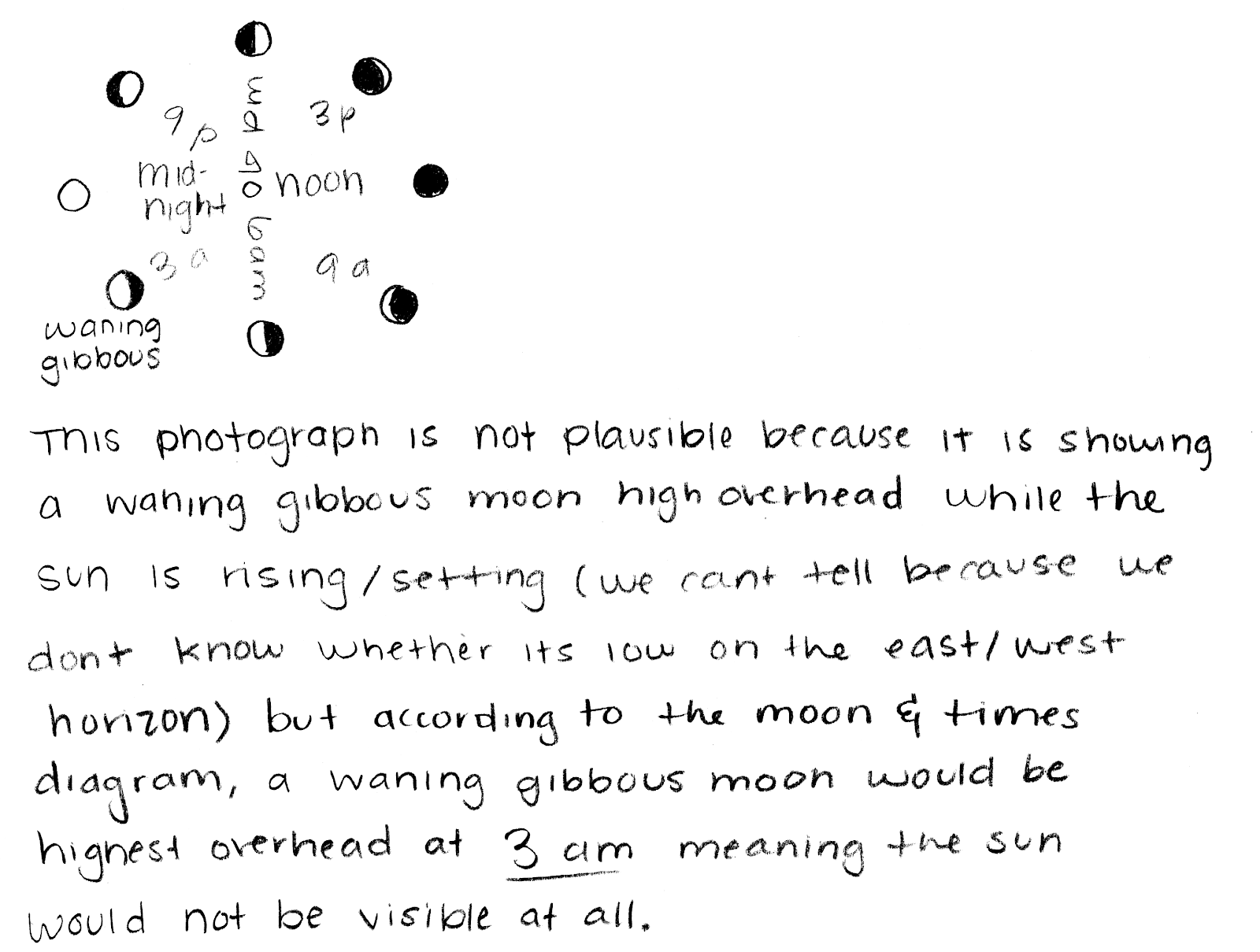Cuesta College, San Luis Obispo, CA
 Shown at right is a photographic montage[*] of the moon, observed by a person on a sand dune, with the sun low in the sky somewhere beyond the right edge of the photograph. Discuss why this composition is not plausible. Support your answer using a diagram showing the positions of the sun, moon, Earth, and an observer on Earth.
Shown at right is a photographic montage[*] of the moon, observed by a person on a sand dune, with the sun low in the sky somewhere beyond the right edge of the photograph. Discuss why this composition is not plausible. Support your answer using a diagram showing the positions of the sun, moon, Earth, and an observer on Earth. [*] instagram.com/p/Bq0oQ9PHlK9.
Solution and grading rubric:
- p:
Complete diagram and reasoning, using one of the following explanations:- identifies the moon as a waning gibbous (due to slightly more than the left side of the moon being illuminated), at or very nearly overhead at or just before 3 AM, which is inconsistent with the sky still illuminated by the sun "low in the sky" sometime during daylight hours (after 6 AM to before 6 PM); or
- identifies the moon as third quarter, which is overhead at 6 AM, argues that is too early for the sun to already be rising "low in the sky," but does not recognize the inconsistency in lighting; or
- recognizing that the moon as shown is illuminated from a light source from the left, which is inconsistent with the sun being low in the sky "somewhere beyond the right edge of the photograph."
- r:
Nearly correct (explanation weak, unclear or only nearly complete); includes extraneous/tangential information; or has minor errors. May make one of the following explanations:- since this is just before sunset (without discussing possibility that this may be just after sunrise), argues how a waning gibbous moon would not be visible then until rising later at 9 PM, when it is dark; or
- misidentifies the moon as waxing gibbous, at or very nearly overhead at 9 PM, which is inconsistent with the sky still illuminated by the sun "low in the sky" sometime during daylight hours (after 6 AM to before 6 PM).
- t:
Contains right ideas, but discussion is unclear/incomplete or contains major errors. Primarily discusses waning crescent moon being overhead. - v:
Limited relevant discussion of supporting evidence of at least some merit, but in an inconsistent or unclear manner. At least attempts to draw a moon phase diagram and apply rise/overhead/set times. - x:
Implementation/application of ideas, but credit given for effort rather than merit. Discussion not clearly based on a moon phase diagram. - y:
Irrelevant discussion/effectively blank. - z:
Blank.
Section 30674
Exam code: midterm01NtwT
p: 27 students
r: 3 students
t: 1 student
v: 3 students
x: 0 students
y: 0 students
z: 1 student
Section 30676
Exam code: midterm01SFBk
p: 23 students
r: 11 students
t: 6 students
v: 3 students
x: 1 student
y: 0 students
z: 0 students
A sample "p" response (from student 2005), discussing that the sun would not be out in the sky when the waning gibbous moon is high overhead:

Another sample "p" response (from student 2517), observing that the wrong side of the moon is illuminated:

Another sample "p" response (from student 7563), making both arguments mentioned above:

A sample "r" response (from student 1377), only discussing how the waning gibbous moon would not be visible at sunset:

Another sample "r" response (from student 1106), instead identifying this as a waxing gibbous moon, which would not be high overhead during daylight hours:

No comments:
Post a Comment